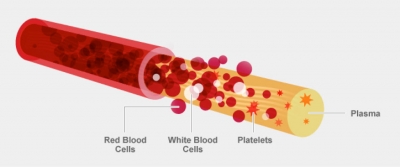
Blood consists mostly of fluid called plasma, together with three types of blood cell – red blood cells, white blood cells, and platelets. They all have different jobs to carry out inside the body.
Blood breakdown
Plasma is made of water with substances dissolved in it, including salts, nutrients, and hormones. Red blood cells take oxygen to cells and remove carbon dioxide. White blood cells hunt and kill bacteria and viruses, while platelets repair damage by plugging a wound and helping blood to clot (thicken).
Plasma
When a blood vessel tears, platelets and plasma proteins work together to stop blood loss. Pale yellow plasma is 91% water.
Platelets
Rounded platelets become spiky when blood clots. Platelets, also called thrombocytes, clump and form a plug in the damaged area. The proteins form threads called fibrins to complete the platelet plug, or clot.
White blood cells
These cells are the largest in the blood. White blood cells, also called leukocytes, are the disease-fighting components of blood. They account for just 1% of circulating blood but multiply during infection or inflammation. There are five types of white blood cells: neutrophils, eosinophils, basophils, lymphocytes, and monocytes. Neutrophils are the most abundant, comprising 60% to 70% of all white blood cells.
Red blood cells
Just under half of blood is made up of red blood cells. Red blood cells, also called erythrocytes, make up most of that 45%. Their primary function is to transport oxygen from the lungs to the cells of the body. Red blood cells are disc-shaped. They are flexible and bioconcave—flat and round with depressed centers.
Picture Credit : Google
